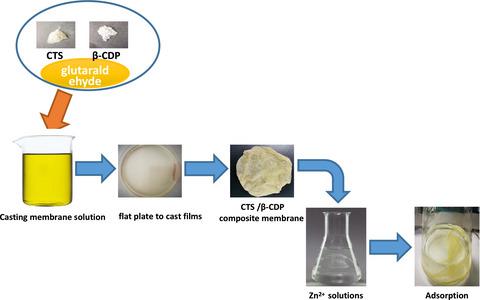当前位置:
X-MOL 学术
›
J. Food Biochem.
›
论文详情
Our official English website, www.x-mol.net, welcomes your feedback! (Note: you will need to create a separate account there.)
Zn2+ adsorption from wastewater using a chitosan/β‐cyclodextrin‐based composite membrane
Journal of Food Biochemistry ( IF 4 ) Pub Date : 2020-10-12 , DOI: 10.1111/jfbc.13483 Jiaxin Liu 1 , Siqi Wang 1 , Jingyi Fu 1 , Xiuqing Ding 1 , Jun Zhao 1
Journal of Food Biochemistry ( IF 4 ) Pub Date : 2020-10-12 , DOI: 10.1111/jfbc.13483 Jiaxin Liu 1 , Siqi Wang 1 , Jingyi Fu 1 , Xiuqing Ding 1 , Jun Zhao 1
Affiliation

|
In this study, a β‐cyclodextrin polymer (β‐CDP) was synthesized by pretreating β‐cyclodextrin (β‐CD) with citric acid (CA), and then, chitosan (CTS) and β‐CDP were cross‐linked to prepare a biomass‐based (CTS/β‐CDP) composite membrane. The effects of the preparation conditions in sodium hydroxide on the adsorption amount and adsorption rate of zinc ions (Zn2+) from simulated wastewater were investigated. The results showed that a maximum adsorption amount 123.7 μg/g and adsorption rate 94.14% of Zn2+ were obtained when the reaction between CTS and β‐CDP was performed at 50°C, the concentration of acetic acid was 2%, dissolving β‐CDP water dosage was 30 ml, and the soaking time in sodium hydroxide was 1 hr. Comparative studies on the adsorption of CTS membranes, β‐CD, β‐CDP, and CTS/β‐CDP composite membrane showed that the CTS/β‐CDP composite membrane had the highest Zn2+ adsorption efficiency. The CTS/β‐CDP composite membrane was characterized by FTIR, SEM, and XRD. Characteristic absorption peaks of CTS and β‐CDP appeared in the FTIR spectra of the CTS/β‐CDP composite membrane, confirming its synthesis. The SEM images showed that the surface of the composite membrane was rougher than the porous CTS membrane, which increased the number of adsorption sites and the adsorption efficiency. XRD patterns showed that the CTS/β‐CDP composite membrane was amorphous, indicating that β‐CDP changed the crystal structure of the CTS. The swelling degree and transmittance of the CTS/β‐CDP composite membrane were lower than the CTS membrane, which should be conducive to recycling after wastewater treatment.
中文翻译:

基于壳聚糖/β-环糊精的复合膜吸附废水中的Zn2 +
在这项研究中,通过用柠檬酸(CA)预处理β-环糊精(β-CD)合成β-环糊精聚合物(β-CDP),然后将壳聚糖(CTS)和β-CDP交联以制备基于生物质的(CTS /β-CDP)复合膜。研究了氢氧化钠制备条件对模拟废水中锌离子(Zn 2+)的吸附量和吸附速率的影响。结果表明,最大吸附量为123.7μg/ g,Zn 2+的吸附率为94.14%。当CTS和β-CDP在50°C下进行反应时,乙酸浓度为2%,β-CDP水溶解量为30 ml,在氢氧化钠中的浸泡时间为1小时,得到的C. 对CTS膜,β-CD,β-CDP和CTS /β-CDP复合膜吸附的比较研究表明,CTS /β-CDP复合膜具有最高的Zn 2+吸附效率。通过FTIR,SEM和XRD对CTS /β-CDP复合膜进行了表征。CTS /β-CDP复合膜的FTIR光谱中出现了CTS和β-CDP的特征吸收峰,证实了其合成。SEM图像表明,复合膜的表面比多孔CTS膜更粗糙,从而增加了吸附位点的数量和吸附效率。XRD图谱表明CTS /β-CDP复合膜是非晶态的,表明β-CDP改变了CTS的晶体结构。CTS /β-CDP复合膜的溶胀度和透光率低于CTS膜,这有利于废水处理后的回收利用。
更新日期:2020-10-12
中文翻译:

基于壳聚糖/β-环糊精的复合膜吸附废水中的Zn2 +
在这项研究中,通过用柠檬酸(CA)预处理β-环糊精(β-CD)合成β-环糊精聚合物(β-CDP),然后将壳聚糖(CTS)和β-CDP交联以制备基于生物质的(CTS /β-CDP)复合膜。研究了氢氧化钠制备条件对模拟废水中锌离子(Zn 2+)的吸附量和吸附速率的影响。结果表明,最大吸附量为123.7μg/ g,Zn 2+的吸附率为94.14%。当CTS和β-CDP在50°C下进行反应时,乙酸浓度为2%,β-CDP水溶解量为30 ml,在氢氧化钠中的浸泡时间为1小时,得到的C. 对CTS膜,β-CD,β-CDP和CTS /β-CDP复合膜吸附的比较研究表明,CTS /β-CDP复合膜具有最高的Zn 2+吸附效率。通过FTIR,SEM和XRD对CTS /β-CDP复合膜进行了表征。CTS /β-CDP复合膜的FTIR光谱中出现了CTS和β-CDP的特征吸收峰,证实了其合成。SEM图像表明,复合膜的表面比多孔CTS膜更粗糙,从而增加了吸附位点的数量和吸附效率。XRD图谱表明CTS /β-CDP复合膜是非晶态的,表明β-CDP改变了CTS的晶体结构。CTS /β-CDP复合膜的溶胀度和透光率低于CTS膜,这有利于废水处理后的回收利用。



























 京公网安备 11010802027423号
京公网安备 11010802027423号